Know your pockets from your tails.
This post stems from some conversations I’ve had with readers lately about what a pocket track refers to, or where and what the auxiliary track at Gateway is. This is more of an alignment design topic, rather than a discussion of the physical differences between types of rail.
Pocket tracks are those sandwiched between mainline tracks, some of which are used more frequently than others. For example, Red Line trains always pass through the pocket track at Gateway to go west, and they end in the pocket track in Beaverton Transit Center, but the pocket track near Hollywood (linked photo not mine) is mainly going to be used for something like getting a disabled train out of the way and not as part of normal service.
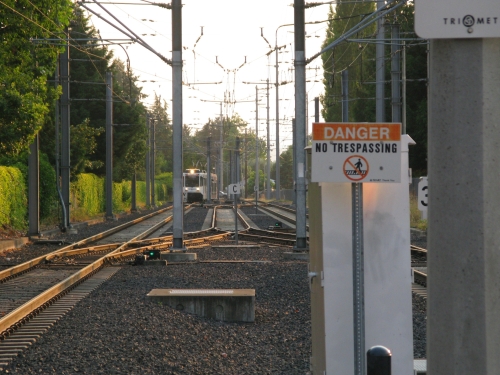 Pocket track by the Fair Complex
Pocket track by the Fair Complex
Pocket tracks are also found near the West Portal of the tunnel, near the airport, and by SE Main Street.
A siding is a track diverged off to the side of the mainline that can be used for turnbacks or temporary storage.
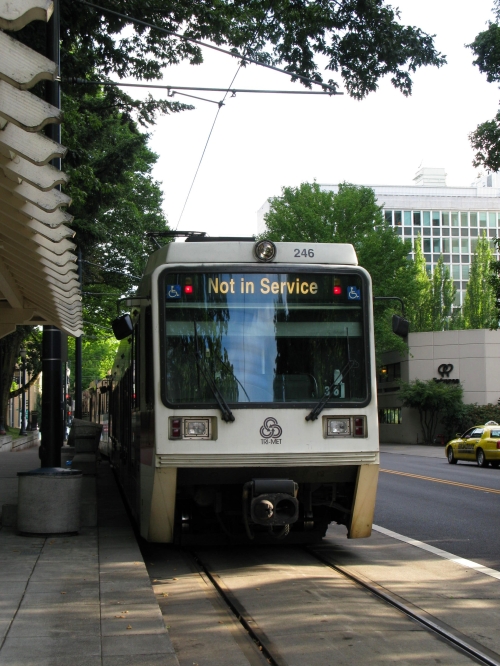 Doubletree Siding with an out of service train- this siding had also been used by the Vintage Trolley
Doubletree Siding with an out of service train- this siding had also been used by the Vintage Trolley
Another siding under the Broadway Bridge (linked picture is not one of mine) has been used for tripper trains. For example, some rush hour service trains that start from Hillsboro would go just past Interstate Rose Quarter, and then pull into the siding to swap cabs and go back west.
A tail track is a track just beyond the end of the line that can be used for storing a train.
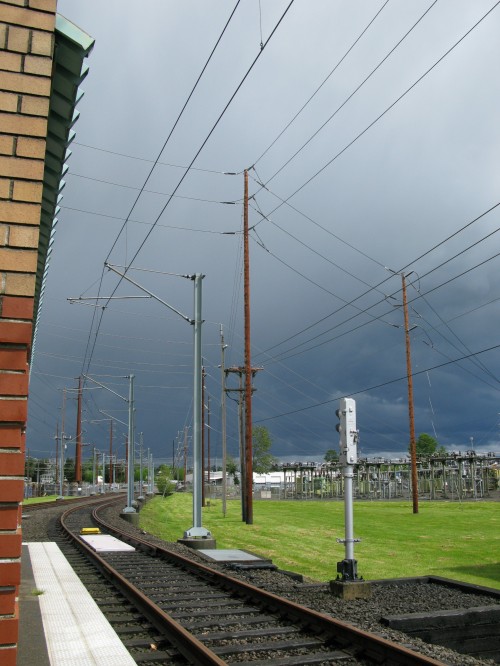 Looking toward one of the tail tracks at Cleveland Avenue
Looking toward one of the tail tracks at Cleveland Avenue
There are also several auxiliary tracks at different locations, such as Hatfield, Expo Center, and Gateway. The ones at Hatfield and Expo are functionally very similar: a third track diverging at the end of the line.
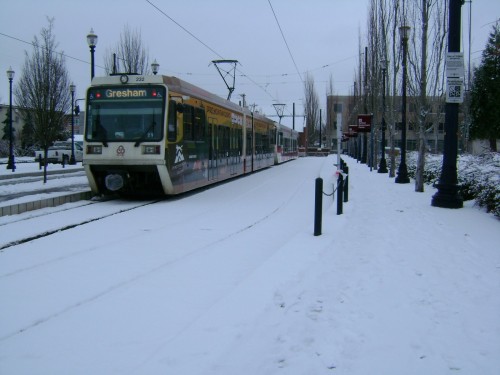 Borrowed picture of the auxiliary track (the snow-covered one with no train in it) at Hatfield a few years ago.
Borrowed picture of the auxiliary track (the snow-covered one with no train in it) at Hatfield a few years ago.
Gateway is actually pretty complex, so here’s a picture*, complete with my excellent MS Paint skills.
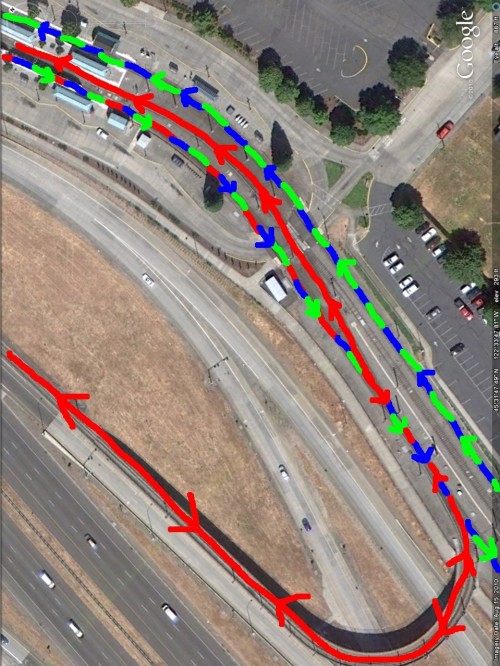 (like all pictures, click for larger version)
(like all pictures, click for larger version)
Okay, so this is not quite oriented the correct way, but it’s close (for a correct view without the color designations over it, go here). The platforms are the area near the upper left corner of the picture – Blue, Red, and Green Lines using the eastbound mainline (the bottom track that has all three colors on it), Blue and Green using the westbound, and Red using the pocket track to go west.
The most identifiable feature is the Red Line’s “fishhook” – a stretch of single track that connects the I-205 north alignment with Gateway. A Red Line will diverge onto the fishhook to go to the airport, and will also come back up the fishhook to go into the pocket track, which is the only track they can access to go west. There’s no way for a Red Line to go directly from the fishhook into the westbound mainline – only Green and Blue Lines will use the westbound main at Gateway.
Notice how there’s a short section of the “eastbound” track that will actually be used by Red Line trains in both directions. This is why you might occasionally be sitting on an eastbound train at Gateway for a while – an incoming Red Line could have locked you out until it gets into the pocket track.
Then there is the one part of the track that doesn’t have a colored line over it, diverging off the pocket track and running between the east and westbound tracks out the bottom right side of the picture – this is Gateway’s auxiliary track.
The Gateway auxiliary track is never used in service to let passengers off the train since there’s no platform there. If an eastbound train needs to be moved into the auxiliary track to be stored, all passengers will exit the train in the Gateway pocket track before the train is moved there.
*This picture is accurate for most trains. Green Lines going from Clackamas to the Ruby yard or from Ruby to Clackamas will use the auxiliary track to get into the pocket to swap cabs and change direction; some Red Lines become Blue at Gateway so it’ll be a Blue coming up the fishhook into the pocket track; if there’s a disabled train in one of the tracks then the pocket can be accessed from either side to get around the broken train, etc, but for most of the service day this is essentially how it works.
Special events tracks – these are found at PGE Park westbound and Rose Quarter (which has the same kind of layout as a pocket track, though the westbound track is not pictured in the linked photo). As the name suggests, these tracks and associated platforms are used for increased service during special events in these locations.
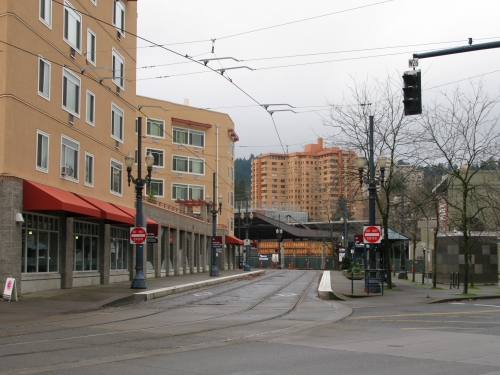 Special Events track at PGE Park
Special Events track at PGE Park
There are also two stub tracks at the north end of the transit mall by Union Station that can be used to store a train. Even though a single-car train is pictured below, both have room to store a two-car train.
To summarize, all of these different types of track layouts increase the flexibility of a rail system by permitting several kinds of train movements and (when necessary) enabling malfunctioning trains to either be temporarily stored out of the way or giving other trains a route to get around them.


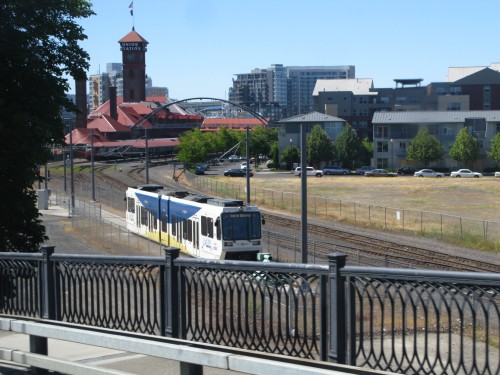
I believe the rail rule book says that a sidings are connected on both ends, meaning that Doubletree technically isn’t a siding.
Also this is a diagram I made of Gateway and how I would improve it.
True, but in the section on signals it refers to signal 20B as being associated with “Doubletree Siding” (same in the section on speeds) and that’s how people refer to it. Granted people also colloquially call the ATS magnets “chiclets” which I don’t think you’d find in the rule book either.
On short bridges, such as the one you go over when leaving willow creek westbound, there are two extra tracks in the middle of each of the two tracks. What are these? That are also these in sunset TC in the short tunnel section under 26.
These are guard rails, basically an extra protection if a train derails on or under a bridge or around some curves.